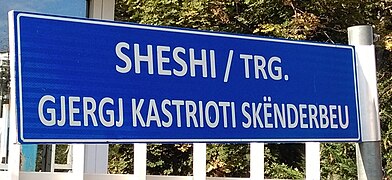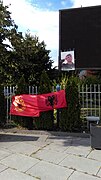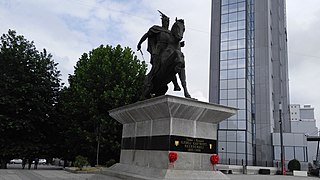Skanderbeg Square, Pristina
Skanderbeg Square Sheshi Skënderbeu | |
|---|---|
| Public square | |
 Skanderbeg's statue in the square | |
| Owner | Pristina Municipality |
| Coordinates: 42°39′49″N 21°09′50″E / 42.6636°N 21.1638°E | |
Skanderbeg Square (Albanian: Sheshi "Skënderbeu") is a square in Pristina, Kosovo.
Location and history
Following the end of the Kosovo conflict in 1999 and longer under Serbian rule, Kosovo Albanians in 2001 erected a monument within the centre of Pristina to Skanderbeg, a medieval Albanian who fought against Ottoman forces.[1][2] Over a journey of four days the statue was brought from Krujë in Albania to the middle of Pristina.[3] The Skanderbeg statue of Pristina shares a similar socialist aesthetic and equestrian posture with minor differences in detail to existing Skanderbeg monuments in Tiranë, Skopje and other places in Europe.[3] Skanderbeg is depicted on a horse with its right leg up in a menacing pose and his sword is outside of its sheath and pointed toward the ground.[3][4][2] A war memorial dedicated to the victims of the Kosovo war is present in Skanderbeg square along with a series of photographs depicting the missing from the conflict.[5] Skanderbeg Square is bordered on one side by Rugova Square, a space named after the first Kosovo President Ibrahim Rugova and on the other side by Mother Teresa Boulevard, named after Saint Teresa of Calcutta.[2] Along with Tiranë and Skopje, Pristina is one of three Balkan capitals to install a Skanderbeg statue.[6]
Gallery
-
Bilingual sign designating Skanderbeg Square
-
Skanderbeg statue
-
Skanderbeg Square
-
Parade by Kosovo Security Force in square
-
War memorial dedicated to the victims of the Kosovo war
-
Banner with photographs depicting the missing from the conflict
-
Banner and flags honouring the Kosovo Liberation Army
-
Banner with photographs depicting the missing from the conflict
-
Poster of Skanderbeg in square
-
Pedestal plaque of the Skanderbeg statue
-
Skanderbeg statue on old pedestal (2000s)
-
Skanderbeg statue on new pedestal (2010s)
See also
- Skanderbeg Square in Tiranë, Albania
- Skanderbeg Square in Skopje, North Macedonia
References
- ^ Ragaru 2008, pp. 531, 549-550.
- ^ a b c Björkdahl & Kappler 2017, pp. 57-58.
- ^ a b c Ragaru 2008, pp. 550.
- ^ Di Lellio, Anna; Schwanders-Sievers, Stephanie (2006). "The Legendary Commander: The construction of an Albanian master‐narrative in post‐war Kosovo" (PDF). Nations and Nationalism. 12 (3): 17.
{{cite journal}}: Invalid|ref=harv(help) - ^ Björkdahl, Annika; Kappler, Stefanie (2017). Peacebuilding and spatial transformation: Peace, space and place. Routledge. p. 57. ISBN 9781317409427.
{{cite book}}: Invalid|ref=harv(help) - ^ Ragaru, Nadege (2008). "The Political Uses and Social Lives of "National Heroes": Controversies over Skanderbeg's Statue in Skopje". Südosteuropa. 56 (4): 549–550.
{{cite journal}}: Invalid|ref=harv(help)
External links
 Media related to Skanderbeg Square (Pristina) at Wikimedia Commons
Media related to Skanderbeg Square (Pristina) at Wikimedia Commons













